A complete look at the water hydration needs and requirements of reptiles.
It’s two parts hydrogen and one part oxygen. This amazing liquid known as water makes up approximately two-thirds of the weight of an average amphibian or reptile, and it’s essential for their physical well-being. Not only do internal body processes, such as cell and organ functions, require this precious liquid, but external body processes, such as shedding, are also reliant upon water to function properly. In the case of some herps, such as frogs and salamanders, the absence of water in the physical environment leads to a quick demise. Others, such as desert reptiles, do not seem quite as demanding; however, they also require this vital substance.
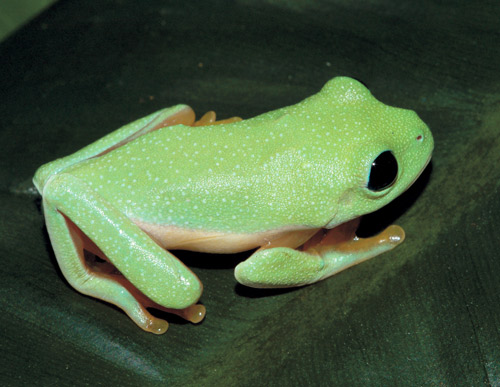
Photo by R. Michael Burger
Rain chambers are excellent for use in breeding treefrogs, such as this Morelet's treefrog (Agalychnis moreletii).
Water is crucial to behavioral processes in amphibians and reptiles, as well. Reproduction in many species, for instance, is often closely tied to water availability in the environment for mating to occur and for egg incubation. Likewise, rain is integral to the food chain, and it ensures that prey is available to newborn herps. Rain also triggers foraging activities in many herps.
OK, so now we all know that herps need water, but just how does someone offer this liquid beyond a mere water bowl? First, it depends upon the herp species kept. Is the animal from a temperate or tropical climate? Is it arboreal, terrestrial or even fossorial (burrowing) in habits? Is it small, medium or large? These are just some of the questions you must consider for providing the optimum water-delivery method to your herp. The following includes the most popular methods for herp hydration.
Water Bowls for Your Reptiles
Apart from the enclosure, water bowls are probably the most important accessory in herpetoculture. The bowl should be untippable, and fresh, clean water should be accessible at all times. There are certain exceptions. Some tortoisekeepers, for instance, soak their animals on a routine basis, but they do not maintain water bowls in the enclosures because they tend to get fouled rather quickly. Pet stores and e-commerce websites often stock water bowls.
Bowl size is important. Depending upon the herp kept, this size can range. For some species a bowl just big enough for the occupant to completely submerge is ideal. For others, one just large enough for the animal’s head to submerse is best. Bowl size can also factor into humidity concerns. A water bowl placed partially over a heating element provides even more humidity as the water evaporates into the air. The larger the surface area of the water, the more water-to-air contact, so more water evaporates.
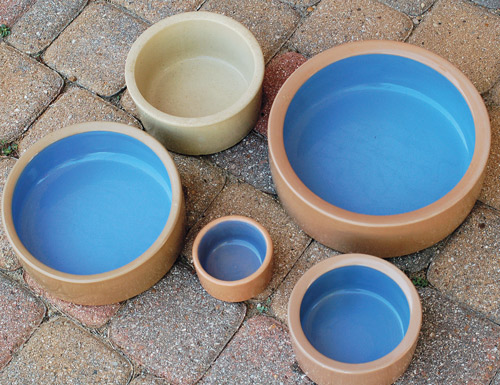
Photo by R. Michael Burger
Providing a water bowl is one of the most important aspects of maintaining a herp.
Scrub and disinfect water bowls weekly to lessen the chance of algae, bacteria and protozoa problems. Mineral deposits, characterized by a whitish sandpaperlike buildup on the inside of the bowl, can be minimized by using vinegar or salt, and letting it soak. Although a variety of disinfectants can be used in a diluted form, bleach is both cheap and effective, and most households have it. Diluting 1 to 3 ounces of bleach per quart of water is recommended. Let the bowl soak for two to three minutes, as a general rule, and thoroughly rinse it before reusing.
Bowl Friendly
Herps benefiting from a water bowl in the enclosure include:
• Corn snakes (Elaphe guttata guttata)
• Ball pythons (Python regius)
• Blue-tongued skinks (Tiliqua spp.)
• Red-eyed treefrogs (Agalychnis callidryas)
• Horned frogs (Ceratophrys spp.)
Reptile Water Drip Systems
Drip systems work well as water-delivery systems for some reptile species, especially arboreal lizards. They allow a continuous but gentle drip to reach the cage occupant. Ready-made drip systems are available at pet stores or online.
If you are inclined to build your own, you can do so with a plastic container, such as a gallon water jug. Prick a tiny hole in the bottom of the container. Hole size is important. If it’s too small, water may not come out. If it’s too big, a stream of water may be created. Err on the too-small side, and enlarge the hole until you reach the appropriate drip interval, which is approximately a drop every second. After puncturing the plastic jug and adding water, place the container atop a cage with a screened lid, and make sure there is ample support for the water-laden jug. It can actually be quite heavy. By experimenting a little, you will find where the drip needs to fall so the cage inhabitant can reach it.
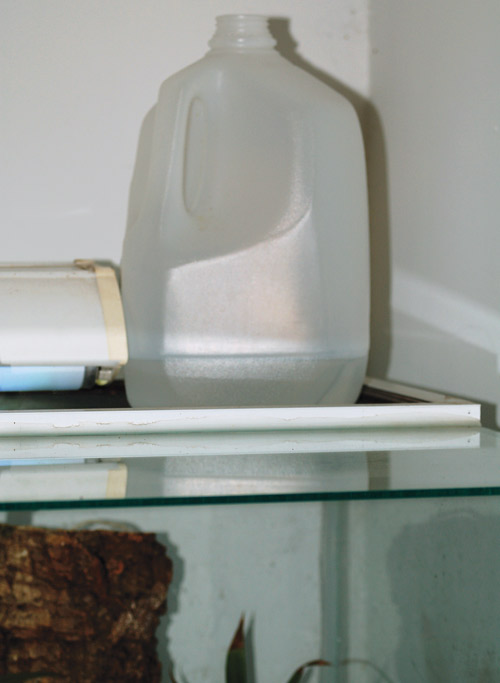
Photo by R. Michael Burger
A simple, easy-to-use drip system can be made from a plastic water jug with a small hole punctured at the bottom. A full water container can get quite heavy, so ensure adequate support for it
An IV drip unit, the kind used in hospitals to provide liquids to patients intravenously, is another system that works well, and you can control the rate of water flow by either opening or closing a simple valvelike mechanism. Water then flows through a small plastic tube, so the tube end can be positioned anywhere water is desired. These units can be acquired through medical- and veterinarian-supply businesses. More elaborate drip systems can be built from microirrigation parts available at home-supply centers. These units work better if you have multiple enclosures needing a water supply, and they can be directly connected via a permanent pipe to external water supplies as well as controlled by timers.
Drip Friendly
Herps benefiting from a drip system in the enclosure include:
• Day geckos (Phelsuma spp.)
• Leaf-tailed geckos (Uroplatus spp.)
• Green anoles (Anolis carolinensis)
• Tokay geckos (Gekko gecko)
• Knight anoles (Anolis equestris)
Reptile Mist Systems
Think of the last time you were in the produce section of a grocery store. Every so often vegetables received a fine mist of water. Likewise, some herp enclosures benefit from a misting system. Misting can be essential for providing drinking water to smaller herps, and it increases humidity within an enclosure.
For small enclosures, a hand-held pump sprayer works well. It’s especially useful with amphibian species because it allows you to use treated water free of chlorine and other chemicals often found in water supplies. Some units can be held in one hand and operated by pumping your finger. Others need both hands to operate and must be pumped up with air before operation. They can be found at pet stores and online.
Larger and/or multiple enclosures can be supplied with automated systems much like what grocery stores have. You can find these systems at expos, reptile stores and online. These can either be hard-plumbed directly to the water supply or drawn from a large water container. Using a separate container allows you to carefully monitor the water quality. A small pump can be wired to an automated timer in order to provide mist at the appropriate intervals.
Mist Friendly
Herps benefiting from a mist system in the enclosure include:
• Green tree pythons (Morelia viridis)
• Emerald tree boas (Corallus caninus)
• Day geckos (Phelsuma spp.)
• Red-eyed treefrogs (Agalychnis callidryas)
• Poison frogs (Dendrobates spp.)
Reptile Rain Systems
A rain system can be incorporated within a primary enclosure, or a separate chamber can be used to rain upon herps. Rain systems are practically indispensible for maintaining and reproducing many species. For instance, arboreal snakes such as emerald tree boas (Corallus caninus) usually ignore standing water in a bowl, but they frequently drink when rained upon. A rain system also helps increase activity in many species. Pre-made rain systems can be purchased at an expo, a specialty reptile store or online.
If you wish to build your own, you can do so using a 39-gallon plastic trash can or bucket. It must have holes drilled into the bottom for drainage purposes. Drainage cannot be stressed enough in any rain system. An insufficient number of drainage holes means the container may flood and drown the animals inside. In the trash can lid create a hole slightly larger than a sprinkler ring — they’re found in many home-improvement stores — and cover the hole with plastic-coated mesh. Make sure to seal the edges. Then place a sprinkler ring upside down on top of the lid. If you’re placing arboreal species within this type of rain chamber, add a branch to provide the specimen with an adequate perch.
A simple rain system extremely useful with amphibian species involves an aquarium, a power-head filter, aquarium tubing, and a sprinkler ring or PVC sprinkler bar. A PVC sprinkler bar can be made from PVC plastic pipe acquired from a hardware store. Drill holes into the pipe to allow the “rain” to trickle down. Operation of this system is easy. The power filter draws water from the bottom of the aquarium via plastic aquarium tubing of appropriate size, and water is returned to the aquarium via a sprinkler ring or PVC bar. No matter what system you choose, rainfall duration varies according to the species kept. A few minutes are probably sufficient for hydration purposes, but a couple hours or more may be needed to reproduce some amphibian species. There can be too much of a good thing. In other words, too much or too hard of a rain may be harmful to your pets. For example, a constant barrage of drops too heavy or too rapid may stress them out.
Rain Friendly
Herps benefiting from access to a rain system include:
• Green tree pythons (Morelia viridis)
• Timor monitors (Varanus timorensis)
• Green iguanas (Iguana iguana)
• Red-footed tortoises (Chelonoidis carbonaria)
• Flying treefrogs (Rhacophorus spp.)
Soaking Your Reptiles
Some species rarely drink from a water bowl, so it often becomes necessary to transport them to a container with shallow water for drinking purposes. This hydration solution can also help with dehydration issues, shedding problems and fecal-retention issues.
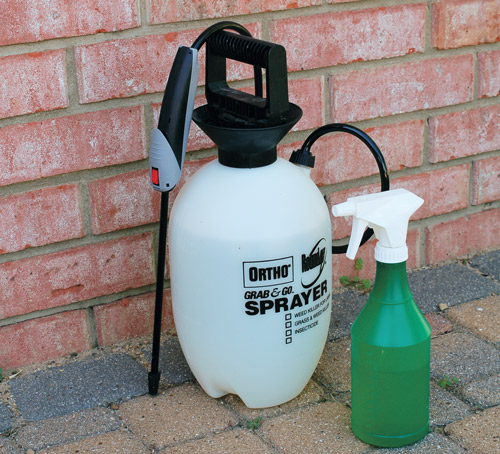
Photo by R. Michael Burger
Hand-held misting units are necessary when maintaining many amphibians and tropical reptiles.
Ensure the water level is sufficiently low enough to prevent drowning. It should measure about half the height of the animal. For example, a 4-inch-tall tortoise should be soaked in water approximately 2 inches deep.
Some tortoisekeepers prefer the method of soaking their tortoises to providing a water bowl because many tortoises quickly foul water bowls. It must be stressed, however, that soaking for hydration purposes should become a routine. It should not be forgotten. Also remember that rain forest species need more water than animals from drier climates. Your herps rely on you to provide everything they need to survive. Because water is so vital, carefully consider your options so your pets are properly hydrated and happy.
Soak Friendly
Herps benefiting from a good soak include:
• Ball pythons (Python regius)
• Boa constrictors (Boa constrictor)
• Box turtles (Terrapene carolina)
• Kingsnakes (Lampropeltis spp.)
• Any tortoise species
Herps not only require water internally, but they also require water for natural body processes, such as shedding their skins.

Photo by R. Michael Burger
A portable rain chamber or rain bucket made from a standard trash can is useful for hydrating certain reptiles. A sprinkler ring provides a steady drizzle while water escapes from holes drilled at the base. A set of bungee cords attached to the handles on the side can secure the lid to prevent animal escapes (or something getting in).
Managing humidity is difficult if you don’t have a way to measure it. Hygrometers measure the relative air humidity, and they are indispensable if you maintain herps that need humidity. Found in pet stores and online, these instruments come in analog and digital models. Most analog hygrometers are accurate but need periodic calibration. Digital hygrometers, on the other hand, offer good accuracy, don’t fall out of calibration, and have a memory for high and low readings. Once you have your hygrometer, use the following five techniques to maintain the correct humidity in your herp’s enclosure.
1. The Natural Touch
Many herps can be successfully kept in enclosures that mimic their natural environments. By using live vegetation and/or natural substrates within an enclosure, humidity levels can substantially be increased. As plants are watered, water evaporates into the environment. Periodically watering plants and/or adding water to the substrate might be required, but excessive watering may create unhealthy conditions such as mold, fungus or stagnant air.
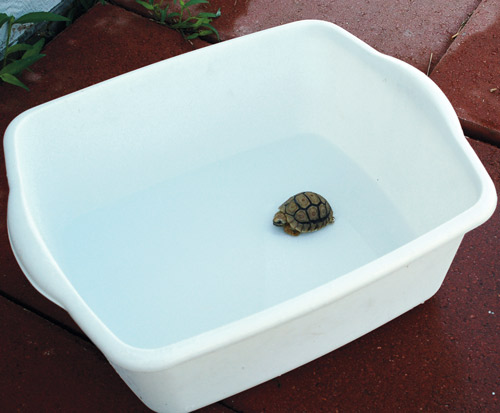
Photo by R. Michael Burger
A juvenile leopard tortoise (Psammobates [Geochelone] pardalis) soaks in a tub. Some herps may need periodic soaking for proper hydration
2. Small-Scale Moisture
A humidity box creates a humid microenvironment in an enclosure. Find a plastic container, such as a sweaterbox, and cut a small hole or doorway, so the animal may comfortably enter and exit. Place dampened moss or another moisture-retaining material inside.
Besides general use as hides, humidity boxes can help prevent snake shedding problems or dehydration in juvenile herps, which are much more prone to it. These boxes apparently also help reduce excessive pyramiding in juvenile tortoises. Although this problem has generally been attributed to dietary problems in the past, recent evidence suggests that inadequate humidity may also be a major issue in these shell malformations.
3. Increases Through Decreases
Partially restricting enclosure ventilation increases humidity. Place Plexiglas or plastic wrap over a portion of the cage top. However, ventilation should not be overly restricted. Experiment and measure humidity levels until you get the ideal conditions.
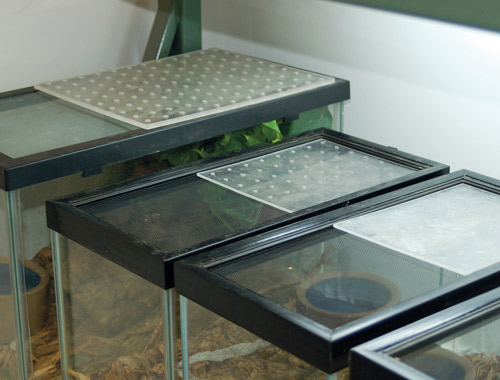
Photo by R. Michael Burger
Partially restricting ventilation is an excellent way to maintain humid conditions, but doing so can cause unhealthy conditions if overdone.
Use this method with caution. Excessively high humidity and stagnant air can create potentially unhealthy conditions. Plastic wrap too close to heat lamps will melt, too.
4. Vaporized
Humidifiers provide a superior method to increase the water content in the air, and they are almost essential during the winter. Although several varieties of humidifiers are available through pet stores and online, cool-mist and ultrasonic humidifiers are probably best for creating humid conditions within herp enclosures.
Cool-mist and ultrasonic humidifiers produce a fine, foglike mist that can be channeled with PVC pipe directly into an enclosure. Because these humidifiers require you to periodically refill them, water quality can be monitored as needed. These humidifiers can create surreal environments similar to a cloud-forest atmosphere that can be extremely useful with amphibian and montane species.
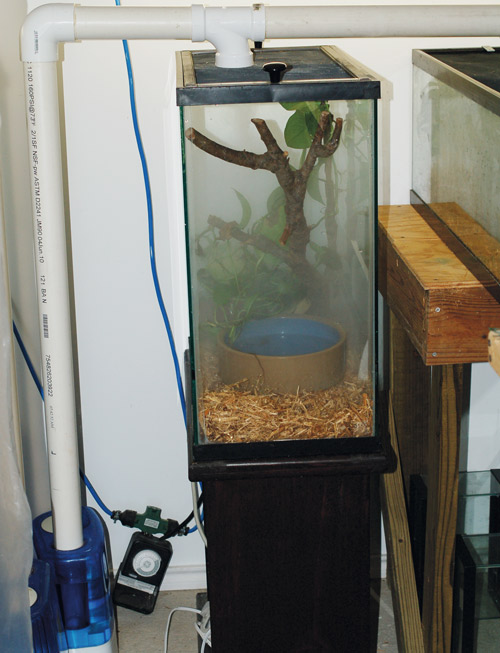
Photo by R. Michael Burger
Cool-mist humidifiers are excellent for use with amphibians and cloud-forest reptiles. The mist can literally be piped into specifc enclosures with PVC piping.
Similar to ultrasonic humidifiers, ultrasonic foggers vaporize water with high-frequency sound waves to produce fog. The unit must be placed about an inch below the water surface to function properly. A sensing probe shuts off the unit if the water level falls too low. Ultrasonic foggers appear to have the greatest use in 10- to 20-gallon tanks, and they are within the price range of ultrasonic humidifiers. They can be found at reptile specialty stores and online.
5. Fully Automated
In this age of just not having enough time to do everything, fully automated is the way to go when setting up some of these systems. There are several options depending upon the number and/or size of the cages and the amount of money you want to spend.
If you’re running a system using an electric pump or humidifier, the first option is purchasing either an analog or digital appliance timer. Although more expensive, digital timers are more precise in allowing you to turn on and off a unit for just seconds at a time. Some digital timers also have a memory backup in case of power failure. Analog timers generally just shut down.
If you’re using a pressurized water supply, such as a faucet, a sprinkler timer is another option. These units generally attach directly to a water faucet. They have an internal valve allowing water to pass. Sprinkler timers are helpful when a number of enclosures or very large enclosures housing reptiles need rain setups. Because tap water, which is chemically treated, is used, never employ this option with amphibians, however. The downside is that timer batteries can die, and some water supplies are too cold to use directly from the tap.
Another option you may want to consider is to purchase a digitally controlled humidistat. This device monitors humidity and can turn a humidifier, misting system or fogger on and off as needed.
Depending upon the model, these units provide programmable humidity settings controlled via an internal digital timer and humidity sensor. This means humidity levels can be raised or lowered according to the time of day. Unlike simple timers, you can actually fine-tune the humidity within an enclosure by using a humidistat.
A humidistat is an especially desirable option when you are maintaining delicate herps, such as day geckos (Phelsuma spp.) and leaf-tailed geckos (Uroplatus spp.).
R. MICHAEL BURGER is a writer, artist, photographer and avid herpetoculturist with more than four decades of experience. His pen-and-ink drawings, photos and articles have appeared in a variety of American and European publications, including books and magazines.



